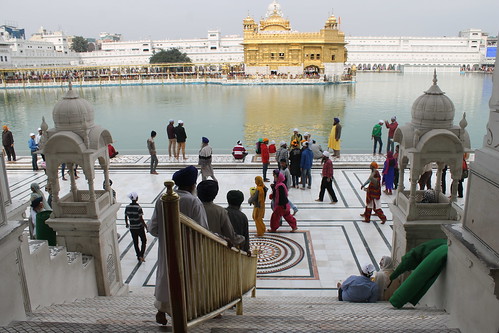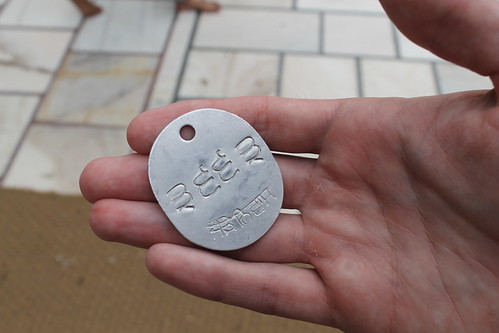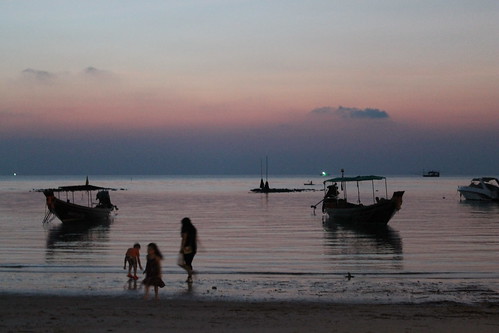Our third day and final day in Yogyakarta began really, obscenely early. We were up at 3:30 am for our earliest departure yet to see the sunrise at Borobudur Temple, an hour and a half outside of Yogyakarta. We picked up a breakfast box left by the staff at the homestay, and stumbled outside in the dark to a driver who ushered us inside a small van occupied by another couple who might have been French or Dutch. We swayed back and forth and slept for a while before arriving at the destination. At 4:30 am, we disembarked and ended up in an outdoor lobby with many other tourists, some looking wide awake, some very quiet and obviously just waking up. We paid our money and received tickets, a map of the complex, a sticker to wear, and a small hand flashlight, as it was still hours from dawn, and then proceeded slowly through the complex. Though the temple doesn’t officially do sunrise tours, the Manohara Hotel, which is on the grounds of the temple, allows people to visit before sunrise for a more expensive ticket price (450.000 IDR or $30 USD per person). Though easily the biggest expense we’d made so far (besides lodging and travel), it was totally worth it. We were able to make our way up the gigantic ziggurat-like structure of the Borobudur temple in near-darkness, with a trail of bobbing flashlights above and below us. After fifteen minutes of hiking up some of the biggest stairs I have ever encountered, we were at the top. Continue reading Java’s ancient temples.
Tag Archives: temples
Two days in Macau.
Despite being just over two hours away by plane, Steve and I had never been to Macau, a former Portuguese colony which is also a hop and skip away from Hong Kong. We decided on a whim to visit this week, and it was a fabulous decision. Macau is a strange little contradiction – a Chinese city with a strong Portuguese presence and heritage, an overseas European settlement now turned Special Administrative Region (SAR) but also a part of China at the same time. We spent two days walking through very twisty streets and ate a lot of sticky sweets and delicious food, and enjoyed seeing some awesome sights.
We flew into Macau on Tuesday in the middle of the day, and it was a bit rough of a start. First, we had no Internet access initially, because the 2G internet afforded by our T-Mobile cards overseas in almost every other country we’ve been to didn’t seem to be working. The driver of the 26 bus that Google had told us to take into the city gruffly informed us we should take the MT4 instead, and I was trying frantically to figure out if we had enough coins in HKD to get on the bus. After purchasing a SIM card out of a vending machine and identifying the MT4, we finally were on our way.
Macau is best known for its gambling, huge lavish and opulent buildings like the Venetian, Sands, and the Wynn. The golden flower shape of the Grand Lisboa skyscraper loomed over the city peninsula and was visible everywhere we went. Since neither of us were much interested in exploring the gambling aspect, though, we decided to make our focus the food and European legacy of Macau. After dropping things off at our hotel the Ole Tai Sam Un, we set off by foot for St. Paul’s Ruins. It’s the second best known thing in Macau, a former church that had been rebuilt and burnt down several times, with the 1843 conflagration leaving just its front façade intact. It sits above a wide flight of stairs and a small square, and today figures into the selfies of pretty much every tourist who visits Macau. The façade is beautiful, and about two feet thick, retaining weathered green bronze statues of St. Ignatius and St. Francis Xavier. We roamed around, and then walked up the hill beside it to the Fortaleza Monte, a small fort which had some beautiful views of the city and was also home to the Museum of Macau. We walked through the small museum, learning about different architectural styles and the history of the numerous forts that had been there before. Continue reading Two days in Macau.
Faith and history in the holy city.
We braved the north of India for nearly a week to visit the holy city of Amritsar and to see its two great sights: the Golden Temple, center of the Sikh religion, and the Indian-Pakistani border at Wagah, which holds a much-vaunted closing ceremony. One of those sights we got to enjoy very much, as we visited the Golden Temple the second night we arrived.

We stayed in a hotel barely minutes away from the Golden Temple. As soon as we were headed inside, I felt the atmosphere change. Though people surrounded us, their glances were more frank and curious than probing and assessing, and no one approached us to ask if we wanted to buy something or if we needed a taxi. Wonders of all wonders! Here, few were curious visitors like us — many more were believers and true Sikhs. Sikhism dictates that inside the temple, all must go barefeet and with their heads covered. (Hence the turban you’ve probably seen Sikh men wear.) At the entrance, we approached the shoe storage center to hand them our shoes and receive a silvery token in return, carved with elaborate numbers. Steve also stopped at a bin filled with squares of orange cloth and bandannas, and fished out one to wrap around his head. He looked a little like a pirate!


Underneath this bowl of stars.
Today, near sunset, Steve and I stepped off the ferry at Haad Rin Harbor onto Koh Phangan, an island in southern Thailand, widely known as a backpacker haven and the home of the infamous Full Moon Party. We boarded a dusty blue truck (songthaew) with a few other travelers, and rode the dipping, screeching truck for almost half an hour over the hilly island before spilling onto Haad Yao in the northwest corner of the island where we were staying. Upon first impressions, Koh Phangan is gorgeous. Our songthaew took us over a dozen hills and valleys at breakneck pace, and at times, we could catch a glimpse of the sun setting over a glittering ocean. When we got into our room, the first thing we did was change into bathing suits and run down the road for the beach.

And it was endlessly gorgeous. Haad Yao is a long sandy beach that curves to face west, and we walked the length of it in the ankle-length water, savoring the sunset. The sun had just disappeared behind the low cloud cover on the horizon, but it lit up everything else. We kept looking up as we walked, as the sunset changed by the minute, tinting the delicate, thin clouds at first a dusty pink and lavender and then changing to saffron, orange, and red. I couldn’t get over how incredibly wide that sky was above us. I didn’t bring my camera because I deliberately wanted to absorb that first sunset, but even if I did, I wouldn’t have known where to begin taking pictures. I wished that I had a large enough lens to capture the entire horizon of the sunset, because you have to see the full spectrum of that sky, from the silhouette of tall palms against that muted blue all the way to the fiery red that underlined the horizon, to appreciate what an amazing view it was.

Moving out, on, and up!
On Tuesday, we sold and donated the last of our belongings (a six-cup coffee maker, a bamboo mattress pad, an IKEA duvtet ) to some grateful expats in Kaohsiung and moved out of our small studio apartment on Lane 123, Linsen First Road. It was beautiful in that place, even if it had no kitchen — the sliding glass doors to the small balcony faced south, and from dawn to dusk, it needed no more illumination than the sun. And in Kaohsiung, it was always sunny! We stayed for two nights in the same hostel we found when we first came here, and said goodbye to the group of friends we had met through Couchsurfing with a few pitchers of San Miguel. And on a bright, sunny afternoon, boarded the train for Tainan.
It was barely a trip — even taking the local train which stopped every 10 minutes at small, out-of-the-way stations, it was only an hour before we arrived in Tainan, the old southern capital of Taiwan. Tainan’s a whole different universe, and sometime soon, when I have all my photos uploaded and categorized on Flickr, I’ll post some here. But it feels a little like Boston and a little like Japan — ungridded, somewhat disorganized, bereft of real sidewalks; large trees abound everywhere, old temples better preserved than any I’ve seen in China, and overall, just a cozier atmosphere than Kaohsiung. After touring several temples, all within easy walking distance of each other, Steve and I had a late lunch at a local place, him enjoying vegetable noodles with soybean paste (炸酱面) and me chicken curry over rice. We sipped tea from next door and watched trains stop the local traffic.
We’re spending a lot of time with Kate, our friend from Chicago. She was born and grew up in Kaohsiung, and her missionary parents currently work at the Tainan Theological College and Seminary, where we are staying. Being able to learn a little about temples and sights from them is really awesome and humbling. They also make their own bread, scorning Taiwanese standards for toast, and that made for a very satisfying breakfast. Kate and Gene, her husband, and Gene’s parents are visiting, which has been nice — it is good to see friendly, familiar faces from Chicago.
Here’s to several more lazy days around this quaint capital of the south before we head north. Between Steve’s admiring comments about the food and the scenery and my own longings for the tea drinks here, I am starting to suspect that we will miss Taiwan very, very much.
Connie